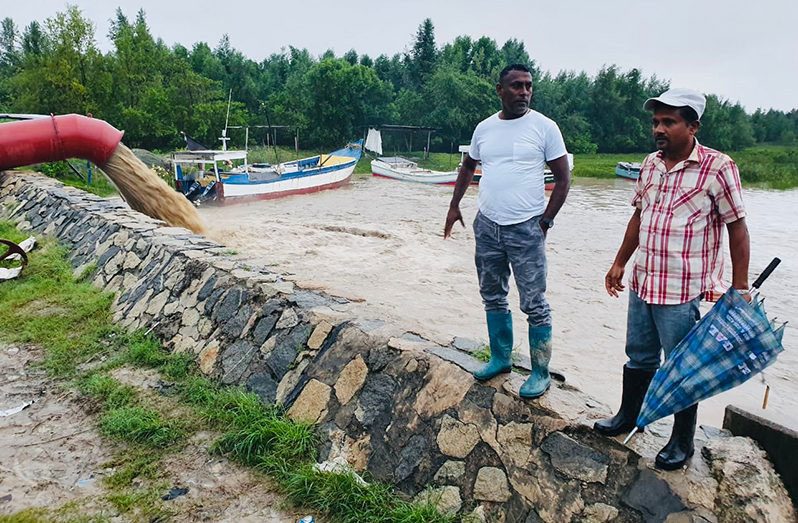DUE to moderately improved weather conditions and drainage of lands, floodwaters have begun to recede across the country; however, given the extent of the flooding, there still remains some amount of water in some communities. According to the Civil Defence Commission (CDC), there has also been a slight increase in shelter operations, with a new shelter being established at the Rockstone Guest House, which is housing seven persons as at June 28. Overall, the number of persons occupying shelters has increased to a total of 239 persons, who are being housed in a total of 10 shelters activated in Regions Two, Five, Nine and 10. The number includes 30 persons at the Barama Building in Karawab, Region Two; seven persons at the Mortice Primary HM Building in Region Five; four at a shelter in Tabatinga, Region Nine; and 198 persons across seven shelters in Region 10.
There are 133 females and 106 males in those shelters. Floodwaters in the coastal regions have mostly receded while there have also been significant improvements in Region Nine where the floods have receded from several communities including the township of Lethem. In the other interior regions, there has been significant drop in the water level.
The CDC, in a release, noted that monitoring across all regions for waterborne diseases continues and some minor cases involving rashes and diarrhea have begun to be reported in some areas. These cases are being sufficiently dealt with by the Ministry of Health, while medical kits are also being deployed by the CDC.
Below is an outline of the situation in the respective regions.
REGION ONE
Floodwaters have receded in riverine communities and have dropped to normal levels in the Barama River; however some areas mostly farmlands remain water-logged.
REGION TWO
Floodwaters have receded in all previously affected communities including those on the Coast and in the Pomeroon River, while there has been no new reports of flooding.
REGION THREE
Floodwaters have receded from most communities previously affected; however some farmlands still remain inundated.
All necessary structures continue to be monitored by engineers and field rangers, with machinery and workers having been mobilised by the regional administration, National Drainage and Irrigation Authority (NDIA), and Community Infrastructure Improvement Project (CIIP), which continue to assist affected communities in the region.
REGION FOUR
In Region Four, floodwaters have significantly receded in several previously affected communities in Georgetown, East Coast and East Bank areas. The Regional Democratic Council (RDC) has been placing much emphasis on the drainage situation around the region.
The Neighbourhood Democratic Councils (NDCs) also continue to do emergency cleaning and monitoring of affected communities with a number of CIIP workers being dispatched across the region.
REGION FIVE
At the Mahaica Creek area water has dropped by approximately one inch in the communities of Big Baiboo, Handsome Tree, District #10, Broken Waterhand and De Hoop but the water still remains high at approximately two feet.
In the Mahaicony Creek area water has dropped by approximately 14 inches in Hyde Park, by three inches in Gordon Table and Wash Clothes, and by one inch in First Savanah. However, there is little to no change in Mortice, Esau and Jacob, Mora Point, Water Dog Creek, Pine Ground and Governors Light, which remains inundated with about two to three feet of water.
The entire communities of Burma Housing Scheme and Moraikobai Village remain flooded with about two to four feet of water. The RDC confirmed houses and farmlands are still under water in all the affected communities.
At Abary Creek water has dropped by one inch.
REGION SIX
As a result of improved weather conditions and operable pumps, water has receded in communities across the region except in Macedonia, which remains flooded because of poor drainage. The NDCs continue to monitor and render support to the region, while excavators are assisting with the desilting of canals in farming areas.
REGION SEVEN
Water levels have receded by approximately 15 feet in the Kamarang and Mazaruni Rivers. Residents from areas who were previously affected are beginning to return to their homes, shops and dredges.
REGION EIGHT
According to the last report as of Monday 28 June, some 56 households were still inundated. The RDC continues to monitor the situation.
REGION NINE
In Region Nine, water levels have receded in Lethem, Tabatinga, North and Central Lethem and vehicles can now access the villages of Aishalton and Karasabi. However, a major section of the road was washed away by floodwaters at Cracrana.
Several stakeholders in the region continue to assist affected communities while the Guyana Defence Force (GDF) and Guyana Police Force (GPF) continue to monitor the security of the border region.
REGION TEN
Water has receded by approximately 18 inches in Kwakwani, Hururu, Sandhills, Dalawala and Landerville; however, the bottom flats of homes and farmlands are still flooded with about four feet of water. In Maria Elizabeth, Muritaro, Malali and Great falls, water has receded by approximately three to six inches, notwithstanding water levels are still at approximately three feet high with homes and farms are still flooded.












